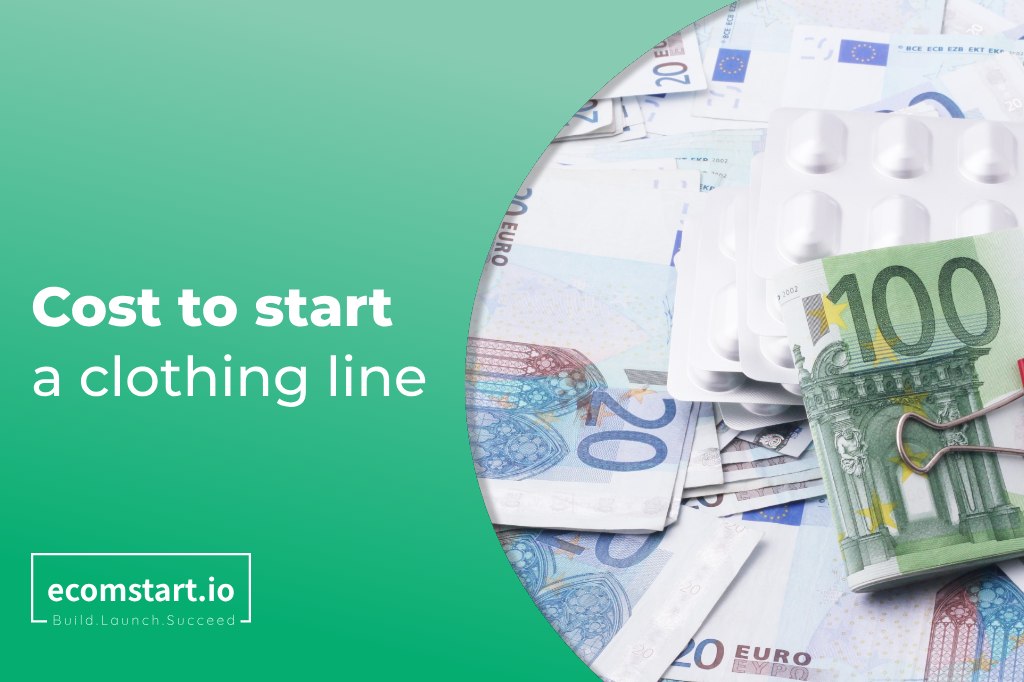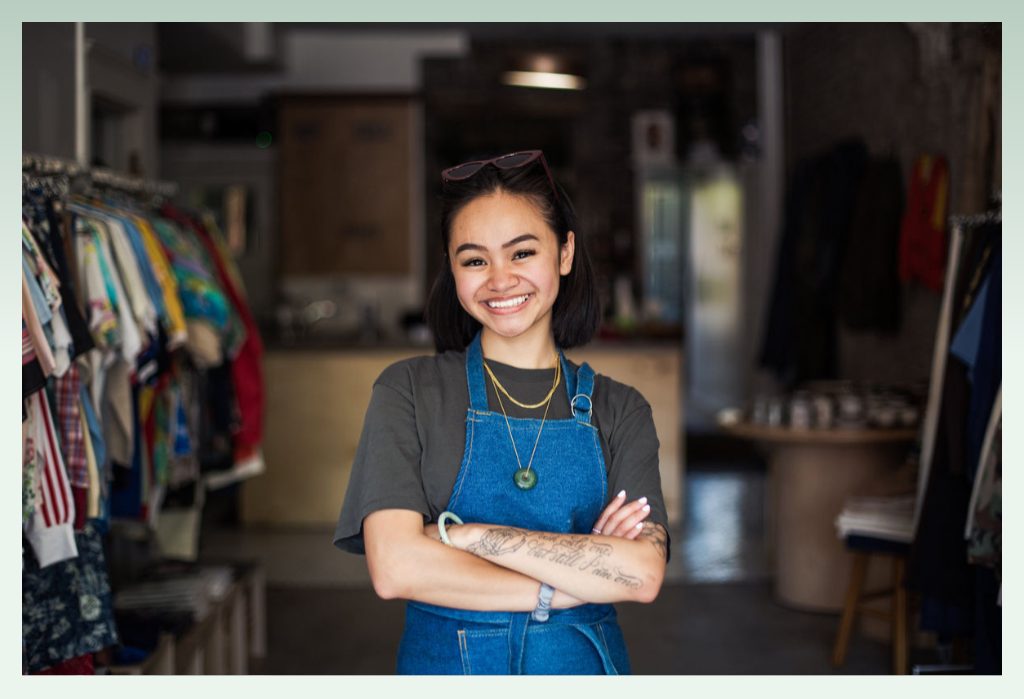How Much to Start a Clothing Line? [2024]

Many argue that the apparel niche has become way too saturated. However, per Global Fashion Industry Statistics by Fashion United, global consumer spending on clothing items is predicted to exceed $2.5 trillion by 2025. Hence, if you are passionate about launching a profitable clothing brand of your own, just do it. But first, you need to know all the potential costs involved for the best budget planning. That’s why, in this article, we’ll give you market-updated information for the question, “How much is it to start a clothing line?”
1. What does “clothing line” mean?

Simply put, a “clothing line” is a collection of clothes sharing a common theme or targeting a specific audience. For instance, you can open a clothing line for a specific season, like a spring or fall collection, or a particular demographic, like kids, plus-size individuals, athletes, etc.
Here are a few popular clothing lines for your better understanding of this term:
- Ralph Lauren Purple Label is a luxury clothing line specifically focusing on modern fashion styles for the male audience.
- GapKids, as the name suggests, is a clothing line by Gap dedicated to producing trendy outfits for children.
- Lululemon Athletica, on the other hand, has a line of clothing designed to serve individuals who are into fitness and yoga.
2. How much is it to start a clothing line?

Depending on the scope you want for your future clothing line, the answer to the question “How much money do you need to start a clothing brand?” will vary remarkably from a mere $500 to a staggering $50,000 upfront.
- Small-sized clothing line
If you want to launch a small clothing line, you don’t have to worry much about the starting cost as it only costs you somewhere between $500 to $1,000.
- Medium-sized clothing line
If you want to start a medium-sized clothing line that outsources production, you need to prepare a budget of $1,000 to $5,000. This will cover basic expenditures to set up your store, like manufacturer’s hiring costs, fabric costs, essential utilities, etc.
- Large-sized clothing line
If you have strong financial capabilities and want to start big, the launching cost of a large-sized clothing line could be anywhere from $10,000 to $50,000 at least, which involves professional manufacturing, a complex supply chain, large-scale advertising, and renting a decent brick-and-mortar store for your clothing line.
3. A detailed cost breakdown of how much to start a clothing line
3.1. Business model
First, ensure you choose the business model that best fits your demand and budget. This is because the business model you choose can significantly impact your cost of starting a clothing line, in general, and manufacturing cost, in particular.
Here are the three most common business models for clothing brands and our estimated cost for each model:
- Traditional retail: The cost of starting this kind of fashion business largely depends on your inventory size, storage costs, rent (if applicable), and the cost of building a website if selling online. For a small startup brand, initial investment could range from $50,000 to $100,000.
- Dropshipping: With the dropshipping model, your starting costs may range from $100 to $5,000 for setting up an eCommerce website and marketing expenses.
- Made-to-order: Made-to-order or custom clothing services manufacture clothing only when customers order. Being a more sustainable method with no surplus stock or fabric waste pressures costs between about $1,000 and $5,000 at a miniature scale.
Now that you know what a clothing line is and how much you expect to invest based on your desired store size, let’s break down all the costs and fees associated with a typical clothing line.
3.2. Manufacturing cost

Manufacturing costs are the first type of cost you need to factor in when estimating how much is it to start a clothing line. Depending on your business model, the quality you expect, and other factors listed below, manufacturing costs can vary significantly. Let’s explore how much does it cost to manufacture clothing.
Product source
The source of your clothing items is another crucial factor in manufacturing costs. If you plan to buy pre-made clothing items, like plain T-shirts for screen printing or embroidery, your expenses will be lower than if you’re designing garments from scratch.
Pre-made clothing items can range from $3 to $10 per piece. Meanwhile, custom-designed pieces with complexities and high-quality materials may cost you around $20 to $100 or more per unit.
Fabric material

If you want to manufacture your clothing products from scratch, choose your fabrics carefully since they are key raw materials that can significantly impact your manufacturing cost.
While basic fabrics like cotton and polyester would normally cost you from $1 to $5 per yard, more premium and specialty fabrics can be considerably more expensive, ranging from $15 to $50 or more per yard.
Trims and accessories
Trims and accessories further add to the cost of manufacturing. For instance, buttons might cost between $0.05 – $0.50 each, while zippers could cost $0.50 – $3.00, depending on their quality and your expected design.
Production Quantity (Low MOQ clothing manufacturers)
If you source your products from suppliers instead of manufacturing yourself, then MOQ (minimum order quantity) fees are another cost you must consider. This fee might get from $20 to $50 per order, depending on the supplier you work with.
Labels and packaging
Custom labels can range from $0.20 – $0.50 per label, while hangtags might cost $0.10 – $0.30 each. Putting them together, you are expected to invest an average of $2 – $5 for packaging per piece.
Shipping and logistics
If you import your products from foreign suppliers, remember to put shipping costs in your budget list. On average, air freight and sea freight would cost you $2.50 – $5.00 per kilogram and $0.50 – $5.00 per kilogram, respectively. Plus, there could be additional customs duties, taxes, and storage costs.
3.3. Design cost

If you choose to start a clothing line from the ground up, remember to jot down the cost of hiring professionals to design your clothing items. For example, the cost of hiring a fashion designer on Upwork is $30/hour for simple design and can go up to $80/hour for advanced design needs.
3.4. Labor and staff expense

If you start your clothing line as a dropshipper, you don’t have to worry about labor costs. However, if you have a brick-and-mortar store or take care of everything from manufacturing to retail and distribution, you must bring staff expenses to the table.
The labor cost for starting a clothing line can largely depend on your expected size, the number of employees needed, their roles, and the location of your business. But here’s a simple breakdown:
- Store manager: Depending on experience and location, you might expect to pay between $30,000 – $60,000 per year.
- Sales associates: Generally earn hourly wages of around $10-15 per hour. Assuming you have two sales associates working full-time (40 hours per week each), that would range from approximately $41,600-$62,400 annually.
- Stock assistant: If your store is large enough to require someone to manage inventory full-time, this could be an additional $20,000 – $30,000 per year.
- If you need part-time employees or seasonal help during busy times, this will also increase your costs accordingly.
3.5. Marketing cost
If you are serious about your clothing line and want it to survive and thrive, you must invest in marketing initiatives to raise brand awareness, educate customers, and, most importantly, scale up your business.

Website
The cost to build and host your website with Shopify, BigCommerce, or Wix can range from around $50 to $400. However, this cost may get from $5,000 to $10,000 if you want to build a scalable eCommerce store using Magento or hire a website development service.
- SEM
If you have just dipped your toe in the game with no branding yet, you need proper investment in SEM– a technique where you pay search engines to display your ads to potential customers. Budgets for SEM can vary greatly based on your bidding, target keywords, ad quality, and more. Hence, SEM might cost you around $1,000 to $10,000 per month.
- SEO
Pouring constant money in paid ads isn’t a stable practice as it will drain your budget in the long run. Therefore, you will have to factor in SEO costs as well. And if you hire an SEO agency, you might have to shell out anywhere from $500 to $2,000 per month.
- Influencers
As Gen-Z customers trust influencers even more than their friends and families, hiring influencers can be an effective way to market your products. Small to mid-level influencers could charge you anywhere from $100 to $1,000 per post. However, working with high-profile influencers or celebrities can quickly run into thousands of dollars per post.
- Social media marketing
Running organic social media campaigns—posting regular updates on platforms like Instagram, Twitter, and Facebook is free, but its reach is limited. So, if you opt for sponsored posts/promotions, add to your budget around $200 to $2,000 per month.
3.6. Rent and utilities

If you want to start a brick-and-mortar clothing store, there are crucial costs called rent and utilities you cannot afford to leave out of the list. Rent and utility costs can vary significantly depending on the location, size, and type of your clothing store.
Rent is often the most substantial overhead cost. If you’re operating in a high-traffic, popular shopping area, you could expect to pay anywhere from $15 – $30 per square foot per year. For smaller cities or towns, you could pay significantly less, say $8 – $20 per square foot per year. A small 1,000-square-foot shop could, therefore, cost anywhere from $800 to $2,500 per month.
Regarding the cost of common utility cost of starting a clothing line:
- A POS system: To efficiently manage sales transactions, process transactions, and keep track of inventory, you’ll need a reliable POS system for clothing stores. And a decent POS system can cost you from $50 to $200/month for software and an upfront investment of $1,000 to $2,000 for hardware, like touch screens, scanners, and receipt printers.
- Electricity: Based on the size of your store and your usage, electricity will cost you $100-$800 per month.
- Internet and phone: Depending on your internet provider and the package you choose, this will cost you from $75-$200 per month.
- Trash and sewage: These costs are usually less variable and range from $30-$70 on a monthly basis.
- Water: If your store has restroom facilities for employees or customers, water bills could cost you between $50-$100 monthly.
- Gas: If your heating is powered by gas, this cost may range between $50-$150 in the winter.
3.7. Legal expenses

And let’s not forget the legal expenses (licenses and permits) to start your clothing line. Depending on the country you plan to launch your store, these fees will differ substantially.
But here’s an estimation for your reference:
- Business license: $50-$400
- Sales tax permit: $0-$100
- Local permits: $100-$300
- Insurance: $500-$1500
- Online seller permits: $20-$100
Summing up the mentioned fees, you are expected to invest around $1,000-$5,000 on legal expenses.
4. Top tips to reduce the cost of starting your clothing line
After scanning through all the possible costs of starting a clothing line, if you are thinking “Wow, that seems like a lot”, then we’ve got some tricks up our sleeves to help you minimize your starting investment.
4.1. Start with an eCommerce
An excellent way to reduce the costs of starting your clothing line is simply starting it online. This will free you from countless costs like renting, utilities, or any other overhead expenses associated with operating a physical store.
Here are the three popular solutions to host your eCommerce web store:
- With its ease of use, Shopify can help you set up an eCommerce store in hours. The platform offers plans ranging from $39 to $399 per month. Though not as scalable as Magento, Shopify’s notable advantage lies in its robust eCommerce features, app variety, and robust customer service.
- Alternatively, Wix is a cost-effective platform with plans starting at just $17 monthly. Wix offers visually appealing templates that are easily customizable with its drag-and-drop editor. However, its eCommerce functionalities might not be as comprehensive as Shopify or Magento.
- Lastly, Magento should be your go-to choice if you’re looking for a powerful platform with superior functionality. Though its pricing can be steep at $2000 to $5000 per month, its vast suite of advanced features and customization options might justify the cost.
4.2. Start small and grow
Instead of risking it all to one shot, we advise you to start small to better understand the market, your competitors, and the market. After testing and finding your winning product, you can scale up your clothing line later by introducing more familiar items.
4.3. Source cost-effective materials
Another tip to minimize your costs is simply to look out for suppliers who offer affordable materials without compromising quality. And remember to order a sample test to make sure that your supplier can also meet your quality standard.
4.4. Outsource the services
Unless you are a big fish, we highly recommend that you outsource services like accounting, marketing, or even designing externally instead of hiring a whole costly in-house team. This will reduce your operation costs beyond your imagination.
4.5. Execute smart marketing
If you truly want to save your cost, only invest in marketing channels that work so you can better allocate your budget. For instance, if your Google ads campaigns have better conversions than Facebook ads, it would be wise to cut down on the Facebook ad costs.
Plus, another marketing tip is diversifying your marketing initiatives. Besides paid ad campaigns, you’ll also need to work on more sustainable and “cheaper” channels like SEO or encouraging word-of-mouth promotion.
4.6. Use dropshipping or print-on-demand service
Last but not least, if you want to start a clothing store without inventory opt for models like dropshipping or print-on-demand. Firms like Printful can manufacture and ship your designs only when an order is placed, eliminating the need for inventory and thereby reducing upfront costs significantly.
5. Conclusion
We’re entering the last quarter of 2023, and clothing is still a promising niche with potential. And we hope after reading this article, you can now have a better picture of how much is it to start a clothing line.


